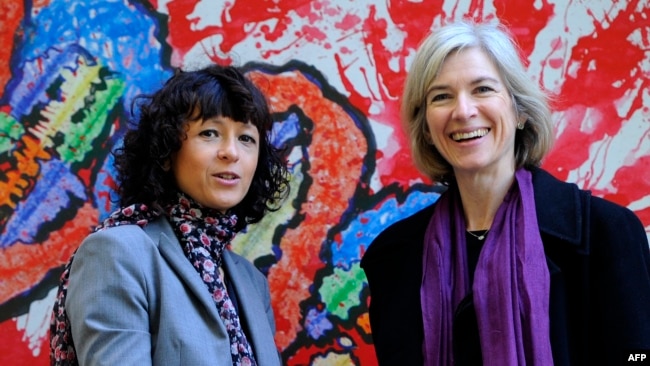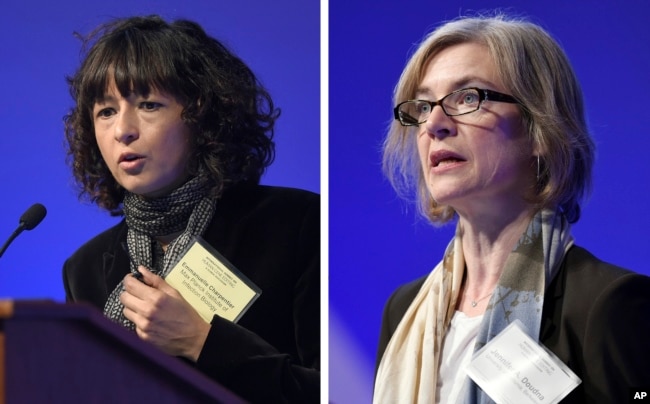う~ん。
倫理的問題をはらむ、今回の受賞。
科学者の正義は、解明し、役立てる研究であることは疑いの余地は全くありません。しかし、、、、
すべてが性善説で成り立っていないこの世界。
この受賞で、”正しい道に進むことを宣言した” と捉えたいです。
今年のノーベル化学賞です。
- フランスとアメリカの女性が遺伝子ツールでノーベル化学賞を受賞
- 遺伝子操作で3人目??
- French, American Women Win Nobel in Chemistry for Genetic Tool
フランスとアメリカの女性が遺伝子ツールでノーベル化学賞を受賞
French, American Women Win Nobel in Chemistry for Genetic Tool
October 07, 2020
フランスとアメリカの科学者たちは、生物の遺伝物質を変えることができるツールを開発したことで、水曜日に2020年のノーベル化学賞を受賞しました。
フランスのエマニュエル・シャルパンティエ氏とアメリカのジェニファー・ダウドナ氏は、CRISPR-cas9として知られる遺伝子ツールを開発しました。このツールは、生命に必要な遺伝情報を保持しているDNAなどの核酸を変えることができる”分子のハサミ”と表現されています。
2020年の化学賞は、ノーベル科学賞が女性のみに授与された4回目の受賞となります。同賞の119年の歴史の中で、女性研究者は男性に比べて研究に対する評価が低いのが現状です。
スウェーデン科学アカデミーは、シャルパンティエ氏とダウドナ氏の発見は、がんの新しい治療法を提供するのに役立ったと述べています。また、何世代にもわたって受け継がれてきた病気を治す方法を提供するかもしれないのです。しかし、このツールはまた、いくつかの倫理的な懸念を提起しています。
’分子のハサミ’
CRISPR-cas9は予想外の発見でした。シャルパンティエ氏は、古代細菌ストレプトコッカス・ピオゲネスの遺伝子を研究していました。この細菌は、人間の感染症の原因となっています。ノーベル委員会は、シャルパンティエ氏の研究が、細菌のRNA、別の核酸、の一部が長いDNA分子を切断できることを示したと述べています。
フランスの科学者は、RNAの専門家であるダウドナ氏と協力しました。彼らは”分子のハサミ”を加工して簡略化したことで、使いやすく、どんなDNA分子でも正確な場所で切ることができるようになりました。スウェーデン王立科学アカデミーの言葉を借りれば: 「DNAが切断された場所は生命の遺伝子情報を簡単に書き換えることができる」
’説明書の変更点’
「この遺伝子ツールには、私たち全員に影響を与える巨大な力があります。」とノーベル化学委員会の委員長であるクラエス・グスタフソン氏はいいます。彼は、遺伝子のどのセットでも編集、または、"遺伝的損傷を修正するために"変更することができると付け加えています。
フランシス・コリンズ氏は、ヒトゲノムの地図作成に尽力した医師です。彼はまた、ダウドナ氏の研究を支援した米国国立衛生研究所の所長でもあります。コリンズ氏は、この技術は鎌状赤血球症のような遺伝的原因を持つ病気への対処法について”すべてを変えてしまった”と述べています。
コリンズ氏は、CRISPRツールとヒトゲノム(染色体上の遺伝子が持つ全情報)のマッピングを組み合わせたことに意味があると述べています。
「ヒトゲノムプロジェクトの成功から、CRISPR-casの力で教則本を変えることに直結することができるのです。」とコリンズ氏は語っています。
この技術はあまりにも大きな力を持っているため、多くの科学者が深刻な倫理的問題を提起していると警告しています。2018年には、中国の科学者 賀建奎He JianKui氏がCRISPRを使って、エイズの原因となるウイルスであるHIVに抵抗するために、複数の人間の胚を遺伝子的に変化させたと発表しました。報告によると、その赤ちゃんは健康に生まれたといいます。
’神を演じること’
しかし、彼の胚に対する実験は安全ではないと世界中で糾弾されました。遺伝子編集された子供たちや将来生まれてくる可能性のある子供たちの長期的な結果は未知数です。
同科学者は昨年、この研究に関連して3年の実刑判決を受けました。
今年9月、国際的な専門家グループの報告書は、赤ちゃんを遺伝子編集しようとするのはまだ早すぎると宣言したのです。
「遺伝子を選択的に編集できるということは、ある意味で神を演じているということなのです 」と、アメリカ化学会のルイス・エチェゴエン会長は述べています。
’若い女の子へのポジティブなメッセージ’
CRISPRツールにつながった研究は、2012年6月に発表されました。そのため、他のノーベル賞受賞者と比較しても、今回の受賞は最近のことです。シャルパンティエ氏は次のように指摘します。"「この発見はわずか8年前のことです...今では誰もがCRIPSR-cas9を使っています。」
ダウドナ 氏は「私の最大の望みは、この発見が生物学の新たな謎を解き明かし、人類のために役立てられることです」と受賞について語っています。
シャルペンティア氏は、女性が科学賞を受賞することの重要性について聞かれ、「これが科学賞の受賞につながることを願っています。科学の道を志す若い女の子たちにポジティブなメッセージを与えることができればと思っています」と答えました。
シャルペンティア氏さんとダウドナ氏の2人をもって、今年はこれまでに3人の女性が科学ノーベル賞を受賞しており、これで7人の女性が化学ノーベル賞を受賞したことになります。水曜日の時点で、57のノーベル賞は女性が受賞しています。マリー・キュリー氏は物理学賞を2回受賞しています。さらに、21世紀に入ってからは、その半数近くの24人が受賞しています。
シャルパンティエ氏とダウドナ氏はCRISPR技術を開発した最初の人として認識されています。しかし、他にも多くの科学者がCRISPR技術に関連した重要な研究を行ってきました。また、ハーバード大学のブロード研究所やマサチューセッツ工科大学との間で、技術の一部の法的所有権を巡って法的な争いも起きています。
51歳のシャルパンティエ氏は現在、ベルリンにあるマックス・プランク病原体科学ユニットの所長を務めています。56歳のダウドナ氏は、ハワード・ヒューズ医学研究所で働き、カリフォルニア大学バークレー校とのつながりがあります。
二人は110万ドルの賞金を共有することになっています。
遺伝子操作で3人目??
French, American Women Win Nobel in Chemistry for Genetic Tool
 (FILE) This file photo taken on October 21, 2015 shows French researcher in Microbiology, Genetics and Biochemistry Emmanuelle Charpentier (L) and US professor of Chemistry and of Molecular and Cell Biology, Jennifer Doudna. (Photo by Miguel RIOPA / AFP)
(FILE) This file photo taken on October 21, 2015 shows French researcher in Microbiology, Genetics and Biochemistry Emmanuelle Charpentier (L) and US professor of Chemistry and of Molecular and Cell Biology, Jennifer Doudna. (Photo by Miguel RIOPA / AFP)
French and American scientists won the 2020 Nobel Prize in Chemistry Wednesday for developing a tool that can change the genetic material of living things.
Emmanuelle Charpentier of France and American Jennifer Doudna developed the genetic tool known as CRISPR-cas9. The tool has been described as “molecular scissors” which can change nucleic acids, such as DNA, which hold the genetic information necessary for life.
The 2020 chemistry prize marks only the fourth time that a Nobel in the sciences was awarded exclusively to women. Female researchers have long received less recognition for their work than men in the prize’s 119-year history.
The Swedish Academy of Sciences said Charpentier and Doudna’s discovery has helped provide new treatments for cancer. It also might supply a way to cure diseases passed down through generations. But the tool also raises some ethical concerns.
‘Molecular scissors’
CRISPR-cas9 came as an unexpected discovery. Charpentier had been studying the genetic material of an ancient bacterium Streptococcus pyogenes. It is a cause of infections in humans. The Nobel committee said that Charpentier’s work showed that part of the bacterium’s RNA, another nucleic acid, can cut long DNA molecules.
The French scientist worked with Doudna who is an expert in RNA. They processed and simplified the “molecular scissors” so they are easier to use and can cut any DNA molecule at an exact place. In the words of the Royal Swedish Academy of Sciences: “Where the DNA is cut it is then easy to rewrite the code of life.”
‘Changes in the instruction book’
“There is enormous power in this genetic tool, which affects us all,” said Claes Gustafsson, the chair of the Nobel Committee for Chemistry. He added that any set of genes can now be edited, or changed, “to fix genetic damage.”
Francis Collins is a doctor who led the effort to map the human genome. He also is director of the U.S. National Institutes of Health which helped support Doudna’s work. He said the technology “has changed everything” about how to deal with diseases with a genetic cause, such as sickle cell disease.
Collins said that the CRISPR tool combined with the mapping of the human genome was meaningful.
“You can draw a direct line from the success of the human genome project to the power of CRISPR-cas to make changes in the instruction book,” he said.
The technology has so much power that many scientists warn that it raises serious ethical questions. In 2018, a Chinese scientist He JianKui announced that he had used CRISPR to genetically change several human embryos to resist HIV, the virus that causes AIDS. The babies reportedly were born healthy.
‘Playing God’
But He’s experimental work on embryos was denounced around the world as unsafe. The long term results for the genetically-edited children and their possible future children are unknowable.
Last year, the scientist was sentenced to three years in prison in connection with his work.
In September of this year, a report from an international group of experts declared that it is still too soon to try to genetically edit babies.
“Being able to selectively edit genes means that you are playing God in a way,” said American Chemistry Society President Luis Echegoyen.
‘A positive message to young girls’
The research that led to the CRISPR tool was published in June 2012. That makes the prize winning effort recent in comparison to other Nobel wins. Charpentier noted: “This discovery is only eight years ago…Everyone is using now the CRIPSR-cas9.”
Of winning the prize, Doudna said, “My greatest hope is that it’s used for good, to uncover new mysteries in biology and to benefit humankind.”
Charpentier was asked about the importance of women winning the science prize. She answered, “I wish this will provide a positive message to young girls who would like to follow the path of science.”
With Charpentier and Doudna, three women have won science Nobel prizes so far this year and seven have now won the prize in Chemistry. As of Wednesday, 57 Nobel Prizes have gone to women. Marie Curie won the Physics prize twice. In addition, nearly half of that number —24— have been awarded in the 21st century.
Charpentier and Doudna have been recognized as the first to develop the CRISPR technology. However, many other scientists have done important work related to it. There has also been a legal dispute with the Broad Institute at Harvard University and the Massachusetts Institute of Technology over legal ownership of some parts of the technology.
The 51-year-old Charpentier is currently the director of the Max Planck Unit for the Science of Pathogens in Berlin. Doudna, who is 56, works for the Howard Hughes Medical Institute and has ties to the University of California, Berkeley.
They are to share the prize valued at $1.1 million.
________________________________________________________________
Words in This Story
scissors –n. (pl.) a tool used for cutting materials made of two blades joined together in the middle so that the sharp edges slide against one another
code –n. signs that identify or gives information about something to someone
genome –n. the complete set of genetic material of a human or another living thing
instruction –n. a statement that describes how to do something
selectively –adv. involving choosing somethings and not others
benefit –v. to be helpful to
